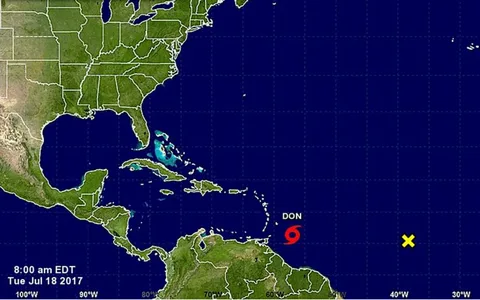Introduction
Every year, from June through November, the Atlantic Ocean becomes the focus of global attention as hurricane season unfolds. Powerful storms with the potential to impact millions of lives form in the warm waters of the Atlantic basin. In the midst of these natural phenomena, the National Hurricane Center plays a critical role. It is the central authority responsible for tracking, forecasting, and issuing warnings about tropical storms and hurricanes in the Atlantic.
This blog explores the functions of the National Hurricane Center, its importance during the Atlantic hurricane season, and how it helps protect lives and property through accurate forecasting and communication.
What is the National Hurricane Center?
The National Hurricane Center, often referred to as the NHC, is a division of the National Weather Service, which is itself part of the National Oceanic and Atmospheric Administration. Located in Miami, Florida, the NHC specializes in forecasting and tracking tropical weather systems in the Atlantic Ocean, Caribbean Sea, and Gulf of Mexico, as well as the Eastern Pacific Ocean.
Founded in 1955, the center has evolved into one of the world’s most respected authorities on tropical meteorology. It works around the clock during hurricane season, using satellite data, aircraft reconnaissance, ocean buoys, and computer models to monitor storm development and issue critical information.
The Atlantic Hurricane Season and Its Patterns
The Atlantic hurricane season officially begins on June 1 and ends on November 30. During this time, weather conditions are most favorable for the formation of tropical cyclones. Warm ocean waters, low wind shear, and moist atmospheric conditions contribute to the development of storms that can grow into hurricanes.
The Atlantic basin includes the North Atlantic Ocean, the Caribbean Sea, and the Gulf of Mexico. Storms can originate in any part of this region and follow various paths depending on prevailing winds and other meteorological factors. The National Hurricane Center continuously monitors these areas for signs of cyclone development.
Each year, the number and intensity of storms vary. Some seasons are relatively quiet, while others see multiple major hurricanes. The NHC issues seasonal outlooks, but the primary focus remains on individual storm monitoring and forecast accuracy.
How the NHC Tracks and Forecasts Storms
The process of tracking and forecasting a hurricane begins long before it makes landfall. The National Hurricane Center uses a wide range of tools to monitor the atmosphere and oceans. Satellite imagery provides a bird’s-eye view of storm systems, while specially equipped aircraft, known as hurricane hunters, fly into storms to collect data on wind speeds, pressure, and humidity.
Once a storm is detected, the NHC begins issuing public advisories that include forecast tracks, wind speed predictions, and potential hazards. These advisories are updated every six hours, or more frequently if a storm is rapidly intensifying.
The forecast cone, a visual tool used by the NHC, shows the probable path of a storm’s center. It helps the public and emergency managers understand which areas may be at risk, though it’s important to remember that impacts such as rain and wind can extend well beyond the cone.
Warnings, Watches, and Public Communication
One of the most important responsibilities of the National Hurricane Center is issuing watches and warnings to alert the public about potential threats. A hurricane watch indicates that hurricane conditions are possible within a certain area, usually within 48 hours. A hurricane warning means those conditions are expected, typically within 36 hours.
These alerts give local governments and residents time to prepare, evacuate if needed, and take steps to reduce risk. The NHC also provides information on storm surge, rainfall totals, and tornado potential—all of which can accompany tropical systems.
The NHC works closely with local meteorologists, emergency management agencies, and the media to ensure its messages are clearly communicated. The goal is to provide timely, accurate, and actionable information that can save lives.
Advances in Hurricane Forecasting
Over the years, hurricane forecasting has seen significant improvements. Thanks to better satellite technology, advanced computer models, and real-time data collection, the National Hurricane Center has greatly increased the accuracy of storm track predictions.
Forecasts that once had large margins of error have become more reliable, allowing communities more time to prepare and reducing the chances of unnecessary evacuations. However, intensity forecasting—predicting how strong a storm will become—remains a challenge, and researchers continue to work on improving this aspect.
The NHC also supports public education initiatives, offering resources to help individuals understand hurricane risks and prepare in advance. This includes evacuation planning, supply lists, and understanding warning systems.
The Importance of the NHC During Disasters
When a major hurricane threatens the United States or neighboring countries, the role of the National Hurricane Center becomes even more critical. The center coordinates with national and international agencies to ensure consistent messaging and support.
By delivering trusted information, the NHC helps communities make informed decisions. This includes not only residents and emergency services but also transportation systems, utility companies, and disaster response teams.
During past storms like Hurricane Katrina, Harvey, Irma, and Ian, the NHC’s forecasts were instrumental in guiding response efforts and minimizing loss of life. The center’s credibility and consistency make it a vital part of the disaster preparedness infrastructure.
Conclusion
The National Hurricane Center is a cornerstone of hurricane preparedness and response in the Atlantic region. Through its advanced forecasting, clear communication, and commitment to public safety, it plays an essential role in helping people stay informed and safe during hurricane season.
As climate patterns shift and storms potentially grow more intense, the work of the NHC becomes even more important. By staying up to date with forecasts and understanding the tools the center provides, individuals and communities can better prepare for the challenges that come with each Atlantic hurricane season.











Comments are closed